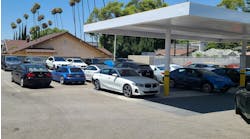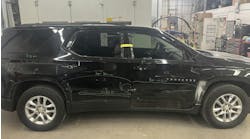A technician’s guide to aluminum repair procedures, techniques
Wow — that is how we will start. In the past two years, we have seen the manufactures of aluminum repair equipment triple, along with the slick, tricked out offerings to save money on new purchases of tools and a lot of misinformation bordering on outright lying. Metallurgy is an important part of being on top of your game, and this has never been more true. We have all started to understand the differences between mild steel (MS), high-strength steel (HSS) and advanced high-strength steel (AHSS), such as boron-alloyed steel, but contrary to popular belief, automotive grade aluminum is NOT all the same. Let’s look at the differences we need to know.
Aluminum tempers and series
In the aluminum fabrication industry the basic tempering designations are as follows:
- F – Fabricated, which applies to products of a forming process in which no special control over thermal or strain hardening conditions is employed.
- O – Annealed, which applies to product that has been heated to produce the lowest strength condition to improve ductility and dimensional stability.
- H – Strain hardened, which applies to products that are strengthened through cold-working (shaping, bending, hammering). In addition to the work hardening process, some supplementary thermal treatment, which produces some reduction in overall strength, may be applied for desired strength. The “H” will always be followed by digits.
- W – Solution heat treated, which is an unstable temper applicable to alloys that age spontaneously at room temperature after heat treatment.
- T – Thermally treated produces stable tempers other than capable in F, O or H treatments. This applies to products that have been heat treated, sometimes with supplementary strain hardening to produce a stable temper. The “T” is always followed by digits.
In the collision repair field, we will only deal with two tempering designations, strain hardened “H” and thermally treated “T” aluminum alloys in wrought ad cast components.
The families, or series as they are called, for wrought aluminum are as follows:
- 1000 series, which is 99 percent pure aluminum
- 2000 series, which is alloyed with copper
- 3000 series, which is alloyed with silicon
- 4000 series, which is alloyed with silicon
- 5000 series, which is alloyed with magnesium
- 6000 series, which is alloyed with magnesium and silicon
- 7000 series, which is alloyed with zinc
The second single digit (xXxx), if different from 0, indicates a modification of the specific alloy, and the third and fourth digits (xxXX) are arbitrary numbers given to identify a specific alloy in the series. Example: In alloy 5554, the number 5 indicates that it is of the magnesium alloy series, the 5 indicates that it is the 5th modification to the original alloy 5054, and the 54 identifies it in the 5xxx series.
The only exception to this alloy numbering system is with the 1xxx series aluminum alloys (pure aluminums) in which case, the last two digits provide the minimum aluminum percentage above 99 percent, i.e., Alloy 1350 (99.50 percent minimum aluminum).
The series for cast aluminum are as follows:
- 1xx.x series, which is 99 percent pure aluminum
- 2xx.x series, which is alloyed with copper
- 3xx.x series, which is alloyed with silicon, copper and/or magnesium
- 4xx.x series, which is alloyed with silicon
- 5xx.x series, which is alloyed with magnesium
- 6xx.x series, UNUSED for cast aluminum
- 7xx.x series, which is alloyed with zinc
The second and third digits (xXX.x) are arbitrary numbers given to identify a specific alloy in the series. The number following the decimal point indicates whether the alloy is a casting (.0) or an ingot (.1 or .2). A capital letter prefix indicates a modification to a specific alloy.
Example: Alloy - A356.0 the capital A (Axxx.x) indicates a modification of alloy 356.0. The number 3 (A3xx.x) indicates that it is of the silicon plus copper and/or magnesium series. The 56 (Ax56.0) identifies the alloy within the 3xx.x series, and the .0 (Axxx.0) indicates that it is a final shape casting and not an ingot. But, in the collision repair field, the only numbers we are concerned with are the series number — 1000 through 7000 series.
Now let’s cover the series and temper designations. If we consider the different series of aluminum alloys, we will see that there are considerable differences in their characteristics and applications, many of which are proprietary to each OEM (secrete). There are two very different types of aluminum the series are categorized into, as we mentioned. These are the heat-treatable aluminum alloys (those that gain strength through the application of heat) and the non-heat treatable aluminum alloys (those that gain strength through forming and work hardening). This distinction is particularly important when considering the effects of arc welding on these two types of materials and reparability. Wrought (sheet) can be repaired in certain situations, while cast and extrusions cannot be repaired. But sheet, extrusions and cast can be welded for replacement procedures. Cracks, tears or other types of damage can never be welded in cast or extrusions. Repairs to cracks and tears in sheet aluminum are extremely limited.
One thousand, 3000 and 5000 series wrought aluminum alloys are non-heat treatable and are strain hardenable only. Two thousand, 6000 and 7000 series wrought aluminum alloys are heat treatable, and the 4000 series consist of both heat treatable and non-heat treatable alloys. The 2xx.x, 3xx.x, 4xx.x and 7xx.x series cast alloys are heat treatable. Strain hardening is not generally applied to castings.
Heat-treatable alloys acquire their optimum mechanical properties through a process of thermal treatment, the most common thermal treatments being solution heat treatment and artificial aging. Solution heat treatment is the process of heating the alloy to an elevated temperature (about 990 degrees F). After heating, quenching generally follows, usually in a water or other liquid, at room temperature. Solution heat treatment is usually followed by aging. Aging is the precipitation of a portion of the elements or compounds from a supersaturated solution in order to yield desirable properties. The aging process is divided into two types: aging at room temperature, which is termed natural aging, and aging at elevated temperatures termed artificial aging. Artificial aging temperatures are typically about 320 degrees F.
The non-heat treatable alloys acquire their optimum mechanical properties through strain hardening. Strain hardening is the method of increasing strength through the application of cold working or work hardening. The temper designation system addresses the material conditions called tempers. The temper designation — the “T” or “H” — and number digit follows the series. Examples: 6061-T4, 6061-T6 or 5052-H32, 5052-H50. For example, many European manufacturers use 6061-T6 or 6111-T6, while Ford utilizes 6111-T4 for many of their aluminum components.
Aluminum equipment
Equipment is a real area of debate. From what we have read and seen there is a definitive divide in information and interpretation of the information. Hopefully, we can clear it up. Here are the basic requirements for the aluminum certified repair facilities and, in actuality, anyone who wants to involved in repairing aluminum. Some of the information is proprietary for some OEMs, so we will talk generally.
- Dedicated structural realignment apparatus, such as Celette, Car-O-Liner, GlobalJig and CarBench. Ford has those manufactures listed and approves Chief. Chief is not approved for the European programs. As of this, writing Spanesi has received some approvals for certain programs, but we have not received confirmation.
- Dedicated and approved dent removal equipment, hammer and dollies
- Dedicated curtain area or isolated room
- Specific and approved rivet equipment
- Approved and specific hand tools, power tools and vacuum systems
- Approved and specific welders with OEM specific requirement and, in some cases, software programs
- Specific and approved training and welding certifications
- Ratchets, sockets, screwdrivers and other hand tools can be shared between steel and aluminum, but it is not recommended. Power tools must be kept separate and dedicated to one or the other.
Metal shaping, fillers and repair times
Misinformation in the market is rampant. It is funny that someone made up the requirement of two hours to set up a vehicle on a frame machine, which is inaccurate, and now others are saying you double the repair time for aluminum, which is only partially true. When shaping aluminum there are few things to remember.
- Aluminum dedicated hammer and dollies should be wood, plastic, aluminum or coated steel. The steel and aluminum hammers and dollies have rounded edges and polished faces. Hammer-off dolly techniques must be used. Aluminum is not easy to move, as it has no memory. The hammer must be stuck so the face lands face flush and not on an angle, where more deformities can be formed.
- Heat must be used on aluminum. You cannot repair cosmetic damage on aluminum — unlike steel — cold. Heat is the primary way to remove most of the damage. As far as structural components, there is generally no pulling or realignment allowed by the OEM. Ford is one company that allows secondary or indirect misalignment to be pulled. The reason Ford allows this is because of their use of T4 alloy tempering verse; other OEMs generally use T6 alloy tempering, which is much harder.
- P80 grit is the coarsest sand paper you can use and is like 50 grit on steel. Most of your sanding will be performed with P100 grit paper and finished with 120, 150 and 180. Although you will use aluminum specific steel-coated files in some situations.
- What you think is repairable on steel may not be repairable on aluminum and what you think is not repairable on steel may actually be repairable on aluminum. Remember backside access is paramount on aluminum, and you must watch out for bonding adhesives and foams, just like steel components, which would make the damage unrepairable and require component replacement. Additionally, like with steel, filler should never exceed 2mm to 3mm maximum. Thinner is better.
- Some OEMs require an aluminum- or OEM-specific filler to be used, while others allow the same filler used on steel components. It is recommended that you use separate containers of filler and mark them for the purpose.
- Aluminum dent-pulling pins are used after heat applications and attempts to remove the damage. Additionally, when welding the pins on, you will generally use only a few, as opposed to steel panels where you may use 15 to 20 pins. Aluminum pins are one-time use and cannot be twisted off. The pins, when done with pulling, are cut and filed down, otherwise you could make holes and then the panel would most likely require replacement.
- Back to repair times. Deformities on aluminum can be removed in minutes or can take hours of applications of heat and massaging with hammer off dolly techniques, when compared to steel. Filler and sanding times are the same; you are metal shaping, not sculpting, the repair area. For example, if we all agreed a dent on the center of a GM door panel (mild steel) is 2.0 hrs, when compared to the same exact dent on a Toyota door panel (HSS), it may be 3.0-4.0 hrs due to the elasticity and ductility of the substrate. But on an Infiniti door panel (aluminum), that same exact 2.0 hr dent may be 1.0-8.0 hrs, or unrepairable. An experienced, well-trained technician can only determine the actual amount of repair time required.
Dos and don’ts
There are many things to remember when attempting to repair an aluminum-intensive vehicle. Some of these dos and don’ts will not make everyone happy, but they are something to consider. Some of the more important things to know are as follows:
- Don’t use aftermarket parts, although many are not available. Additionally, used parts are a don’t. Most OEMs have position statements against their use. Used structural components must never be used.
- Do get the OEM repair information from their website or a third party, like ALLDATA. The OEMs have very specific repair procedures and protocols you must adhere to.
- Don’t be fooled or foolish. Just because you have purchased equipment for one OEM program, it does not mean you can repair all vehicles. For example, many of the approved Ford aluminum program tools and equipment are not approved for the European vehicles; this would be true if you are an Audi aluminum facility and you have a Mercedes-Benz aluminum-intensive vehicle. This includes cosmetic damage. Although the equipment and tools are similar, they are not the same. Additionally, you need to understand most aluminum OEMs restrict structural components for sale only to approved program shops. Many times if you start disassembly and repairs to a restricted aluminum-intensive vehicle, you may have caused irreparable damage even from jacking the vehicle incorrectly. This could mean you will have to purchase the vehicle, as it is now deemed a total loss.
Certified program overviews
Much of the OEMs’ certified program information is proprietary, so we will list general rules. The rules for most of the European and Asian (Nissan GT-R and Lexus LFA) are as follows:
- Dealership sponsorship is required, and a working relationship is needed. Additionally, there are requirements as to how many outside shops (non-dealer owned) may be sponsored, and there are requirements as to how many miles from the dealer the shop is located.
- Equipment purchases must be obtained from the certified program provider and some of the equipment can only be sold to the sponsored program facilities. Welders, rivet guns, hand tools, windshield removal and installation tools, frame equipment, etc.
- Insurance coverage, facility appearance, signage, hours of operation, uniform and dress appearance, parking and towing requirements must be met.
- Shops must fulfill training requirements from I-CAR, ASE certifications and OEM specific training and welding certification. OEM training is generally one day online training prior to attending a 3-, 4- or 5-day training course on a specific vehicle or range of vehicles. Welding requirements can be a 5- to 10-day course, where all test samples are sent to an engineering lab and must pass the ISO 9606-2 standard. Recertification can be once every 6 months to once every two years, based on the OEM program requirements. The cost can be upwards of $16,000 for initial testing.
- Quarterly visits to check on the facility, checks of OEM repair information documentation and customer service reviews are required. Specific OEM-only parts and materials usage, proved with invoices will also be examined and verified.
- There will be surprise spot check visits from the OEM certified collision repair program managers.
- You must meet the requirements of dealer service for computer rests and wheel alignment.
- Specific parts ordering software programs and management of order and receiving dates is required. All restricted parts are drop shipped to the certified facility.
For the Ford F150 program, currently the following would apply:
- Dealership sponsorship is not required for all shops, only those in the Certified program. Anyone can purchase the parts, but it is recommended that all procedures and protocols are followed.
- Equipment purchases can be obtained from the Certified Program provider or from the equipment provider listed in the Ford F150 Program list, which includes welders, rivet guns, hand tools, windshield removal and installation tools, frame equipment, etc.
- Insurance coverage, facility appearance, signage, hours of operation, uniform and dress appearance, parking and towing requirements have to be met by the certified facilities. Non-certified facilities are not required.
- Training requirements are provided by I-CAR, and are open to all facilities. The training program is 8 hours. Welding requirements are provided by I-CAR; it is a 6-8 hour course conducted at your facility. Equipment requirements must be me prior to the test.
- For the certified facilities, a visit from Assured Performance Network is required. Non-certified shops are not required to have an inspection.
We hope this second article, in a six-part series, has helped you understand some of the differences and dispel some of the myths associated with repairing aluminum-intensive vehicles. This is an overview, and we will delve deeper in to each area in detail in our following articles throughout the year.
Subscribe to ABRN and receive articles like this every month…absolutely free! Click here to subscribe.


